Traghetto gondola ferries
Looking for a cheap (if quick) gondola ride in Venice? Take a traghetto across the Grand Canal.

ABOVE: A traghetto, or gondola parada, prepares to leave the San Tomà pier on Venice's Grand Canal.
|
Until 1854, the Ponte di Rialto was the only bridge across the Grand Canal in Venice. Even now, there are only four bridges along the canal's 2.5-mile (3.5 km) length. If you need to cross the canal and you aren't near a bridge, you have two choices:
-
Take the No. 1 vaporetto, which zig-zags from one bank to the other as it follows the Grand Canal, or better yet:
-
Head for the nearest traghetto pier and get rowed to the other side. As a tourist, you'll be expected to pay €2,-- (nearly three times the residents' rate of 70 cents).
Traghetto (plural: traghetti) means "ferry" in Italian. On Venice's Grand Canal, traghetti are the passenger boats that cross the canal at various points between the railroad station and St. Mark's Basin.
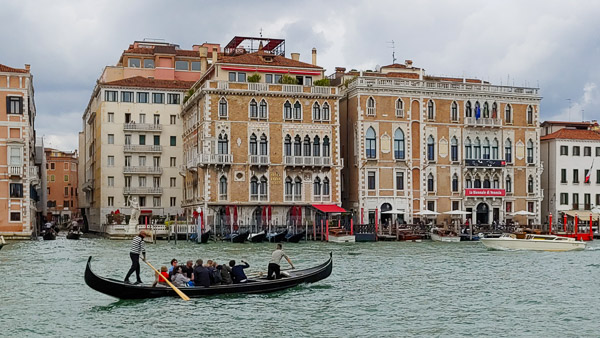
A traghetto, also called a gondola parada, carries up to 10 passengers (compared to five for a privately-hired gondola da nolo). The boats eschew bow decoration, brocaded chairs, and other luxury trimmings. They are rowed by two oarsmen: one who stands behind the passengers like a traditional gondolier, the other closer to the bow.
Most traghetti have been operated by the same families for generations. As recently as the 1950s, there were some 30 of these gondola ferry routes. Today, there are just over half a dozen official routes, although you'll be lucky if you find more than two, three, or four operating at any given time. Two of the most reliable are:
Pescaria (Rialto fish market) - Santa Sofia (near Ca' d'Oro):
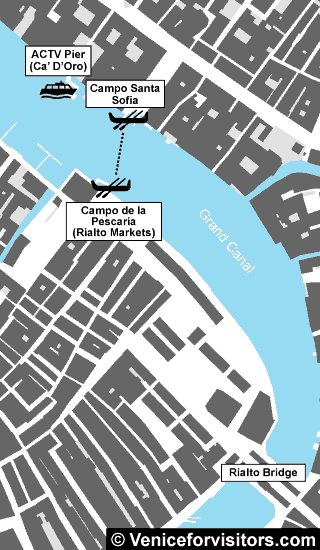
San Tomà - Sant'Angelo:

Two other routes are convenient and operate with some regularity:
-
Giglio, from the gondola station by the Gritti Palace Hotel to Calle Lanza in Dorsoduro (near the Salute Church)
-
Dogana, from a pier near the tip of Dorsoduro to San Marco Vallaresso.
Other official routes are still marked on maps (and often listed in obsolete guidebooks and Web sites), but service ranges from sporadic to non-existent:
-
Fondamente S. Lucia (in front of the railroad station) - Fondamenta San Simeón Piccolo
-
San Marcuola - Fóndaco dei Turchi (by the Natural History Museum)
-
Riva del Carbòn - Fondamente del Vin
-
San Samuele - Ca' Rezzónico
-
Note: Traghetto routes are clearly marked on some Venice street maps (look for straight lines across the Grand Canal), and you'll often see signs on buildings pointing toward the traghetto landings when you're walking through neighborhoods along the Grand Canal.
How to ride a traghetto

ABOVE: A sign at a traghetto pier shows the traghetti's two-tiered pricing scheme.
-
Follow the "Traghetto" signs to the nearest landing, which will be a small wooden pier along the edge of the Grand Canal. Boats normally shuttle back and forth almost continuously, so you shouldn't have to wait long if the service is running.
-
When the traghetto arrives from the other side of the canal, board the boat and find a place to sit or stand. Face backward, because the boat will turn as it leaves the dock. (Venetians traditionally stand during the crossing, but you're welcome to use a seat or perch on the gunwales, and an oarsman may gesture for you to sit down if his last batch of tourists toppled into the canal.)
-
Hand your fare to the oarsman as you board or leave the boat. If you don't have exact change, try to pay with coins instead of banknotes.
-
During busy times of the year, long queues can form at traghetto stations. You'll have to decide for yourself whether it's worth standing in line for a three- or four-minute ride across the Grand Canal.

Venice for first-time visitors:
Other practical advice
-
Don't try to board a traghetto in a wheelchair, with a baby carriage, or with heavy luggage. Instead, use the No. 1 vaporetto, which has a flat deck and is fully accessible.
-
Hours of traghetto service are unpredictable at best. When they're operating, the boats are usually rowed back and forth across the Grand Canal from early in the morning until 7 or 8 p.m., or possibly a bit later in the summer (sometimes with a break for lunch).
If you arrive at a traghetto platform and no boat is in sight, just do as the Venetians do and either take the vaporetto or save money by walking to the nearest bridge across the Grand Canal. (The vaporetto option makes the most sense when you have a one- to seven-day ACTV Travel Pass, which allows unlimited use of public water buses during the period of validity.)
More photos:
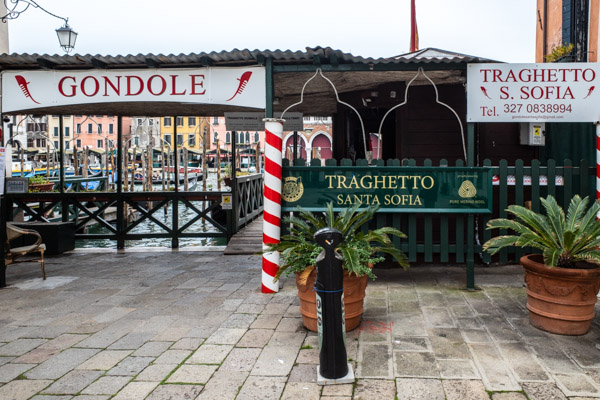

ABOVE: One of the most popular traghetto routes is the Traghetto Santa Sofia, which connects the Campo Santa Sofia with the Pescheria, or Rialto Fish Market.
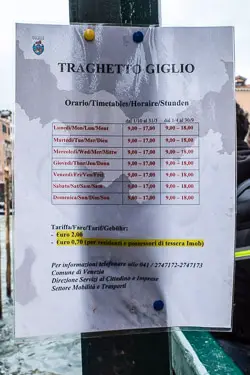
ABOVE: The Giglio traghetto runs between a gondola station on the Campo del Traghetto in San Marco to Calle Lanza in Dorsoduro, not far from the Basilica di Santa Maria della Salute. In this photo, a printed timetable shows operating hours for the Giglio traghetto service.
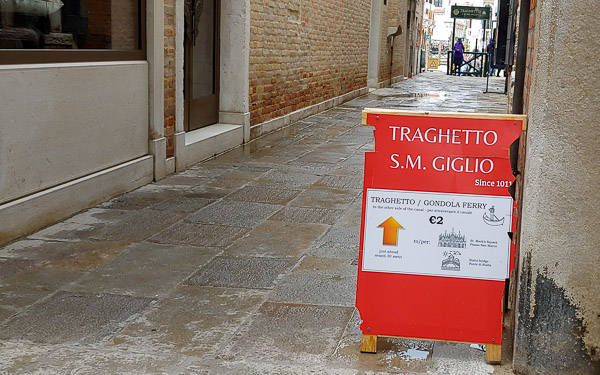

![]()
ABOVE: Sandwich signs along major pedestrian routes often identify traghetto routes that are operating.
Permanent directional signs on buildings aren't always reliable, since a traghetto line (such as the Traghetto San Marcuola) may no longer be in service.

Venice for first-time visitors:
Related video: Traghetto Santa Sofia
 Durant Imboden has
written about Venice, Italy since 1996.
He covered Venice and European travel at About.com for 4-1/2 years before launching
Europe for Visitors (including
Venice for Visitors) with Cheryl
Imboden in 2001.
Durant Imboden has
written about Venice, Italy since 1996.
He covered Venice and European travel at About.com for 4-1/2 years before launching
Europe for Visitors (including
Venice for Visitors) with Cheryl
Imboden in 2001.
PC Magazine has called this "the premier visitors'
site for Venice, Italy." Over the years, it has helped more than 30 million
travelers. For more information, see About our site,
our Europe for Visitors
press clippings,
and
our reader testimonials.
MAP CREDITS: Walking maps by Anders Imboden, using base data from the Comune di Venezia and Regione Veneto under license IODL-2.0.


